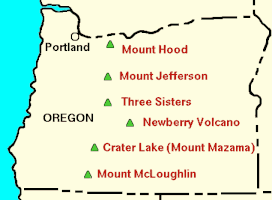
Back جبل هود Arabic Маўнт-Худ Byelorussian Mount Hood (bukid sa Tinipong Bansa, Oregon, Hood River County, lat 45,37, long -121,70) CEB Mount Hood Czech Mynydd Hood Welsh Mount Hood German Monto Hood Esperanto Monte Hood Spanish Mount Hood Basque کوه هود Persian
| Mount Hood | |
|---|---|
 Mount Hood reflected in Mirror Lake | |
| Highest point | |
| Elevation | 11,249 ft (3,429 m) NAVD 88[1] |
| Prominence | 7,706 ft (2,349 m)[2] |
| Listing | |
| Coordinates | 45°22′25″N 121°41′45″W / 45.37361°N 121.69583°W[1] |
| Geography | |
| Location | Clackamas / Hood River counties, Oregon, U.S. |
| Parent range | Cascade Range |
| Topo map | USGS Mount Hood South |
| Geology | |
| Rock age | More than 500,000 years[3] |
| Mountain type | Stratovolcano |
| Volcanic arc | Cascade Volcanic Arc |
| Last eruption | 21 September 1865 to January 1866[4] |
| Climbing | |
| First ascent | July 11, 1857, by Henry Pittock, W. Lymen Chittenden, Wilbur Cornell, and the Rev. T. A. Wood[5] |
| Easiest route | Rock and glacier climb |
Mount Hood, also known as Wy'east, is an active stratovolcano in the Cascade Range and is a member of the Cascade Volcanic Arc. It was formed by a subduction zone on the Pacific Coast and rests in the Pacific Northwest region of the United States. It is located about 50 mi (80 km) east-southeast of Portland, on the border between Clackamas and Hood River counties, and forms part of the Mount Hood National Forest. Much of the mountain outside the ski areas is part of the Mount Hood Wilderness. With a summit elevation of 11,249 ft (3,429 m),[1] it is the highest mountain in the U.S. state of Oregon and is the fourth highest in the Cascade Range.[6] Ski areas on the mountain include Timberline Lodge ski area which offers the only year-round lift-served skiing in North America, Mount Hood Meadows, Mount Hood Skibowl, Summit Ski Area, and Cooper Spur ski area. Mt. Hood attracts an estimated 10,000 climbers a year.[7]
The peak is home to 12 named glaciers and snowfields. Mount Hood is considered the Oregon volcano most likely to erupt.[8] The odds of an eruption in the next 30 years are estimated at between 3 and 7%, so the U.S. Geological Survey (USGS) characterizes it as "potentially active", but the mountain is informally considered dormant.[9]
- ^ a b c "Mount Hood Highest Point". NGS Data Sheet. National Geodetic Survey, National Oceanic and Atmospheric Administration, United States Department of Commerce. Retrieved March 31, 2008.
- ^ "Mount Hood, Oregon". Peakbagger.com. Retrieved June 4, 2011.
- ^ "Mount Hood–History and Hazards of Oregon's Most Recently Active Volcano". U.S. Geological Survey Fact Sheet 060-00. U.S. Geological Survey and U.S. Forest Service. June 13, 2005. Archived from the original on August 22, 2018. Retrieved January 16, 2007.
- ^ "Hood". Global Volcanism Program. Smithsonian Institution. Retrieved June 1, 2009.
- ^ "Glaciers of Oregon". Glaciers of the American West. Archived from the original on October 3, 2010. Retrieved February 24, 2007. quoting McNeil, Fred H. (1937). Wy'east the Mountain, A Chronicle of Mount Hood. Hillsboro, Oregon: Metropolitan Press. OCLC 191334118.
- ^ Swanson, D.A.; et al. (1989). "Mount Hood, Oregon". Cenozoic Volcanism in the Cascade Range and Columbia Plateau, Southern Washington and Northernmost Oregon: AGU Field Trip Guidebook T106, July 3–8, 1989. U.S. Geological Survey. Archived from the original on February 3, 1999. Retrieved July 18, 2013.
- ^ "Climbing Mt. Hood". United States Forest Service. Retrieved October 5, 2024.
- ^ Most likely to erupt based on history; see James S. Aber. "Volcanism of the Cascade Mountains". GO 326/ES 767. Emporia State University. Archived from the original on September 27, 2011. Retrieved July 11, 2007.
- ^ Scott, W.E.; Pierson, T.C.; Schilling, S.P.; Costa, J.E.; Gardner, C.A.; Vallance, J.W.; Major, J.J. (1997). "Volcano Hazards in the Mount Hood Region, Oregon". Open-File Report 97-89. U.S. Geological Survey, Cascades Volcano Observatory. Archived from the original on December 2, 2008.
